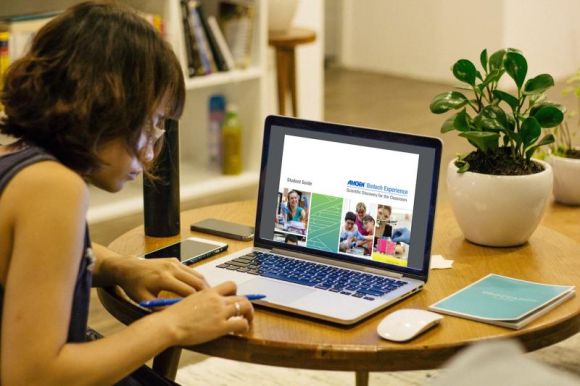This blog post is the first of a two-part post focused on how science teachers can prepare and plan for a transition to online learning during the COVID-19 crisis. In Part 1, we provide recommendations and resources to help prepare for the switch, while in Part 2, we provide support for your online learning planning.
Part 1: Preparing Yourself for Online Instruction
As you begin to explore teaching online, ABE is here to help! In this blog post, we provide some recommendations and resources available to help you make the switch. At first, you may just want to share resources and assignments with your students. As you get more comfortable, you might want to record videos or podcasts for students. From there, you may want to try holding video or chat sessions in which you interact with students in real time.
Making the Switch
Don’t expect the switch to online teaching to be without issues. It is extremely important to remember that school is necessary, but in this time of crisis, it is secondary to peoples’ health and well-being. To begin, ensure that your students have the materials they need at home. If they have not brought their textbooks, what online resources could you use to replace them? Communicate with students to ensure they know when instruction will resume and how you plan to interact with them. Finally, be in communication with your school’s administration and IT team to ensure that you have all the details you need to move forward and know what resources are available to you.
Dipping Your Toe Into the Water
If you’ve never taught online, don’t worry! You may wish to start by simply sharing assignments through email or via Google docs or by holding classes using platforms such as Zoom (which is making the platform free to educators—see below). This process will take time and planning. As you become more comfortable, you may wish to dive more deeply into the features of the Learning Management System available through your school (if any) or create your own website to share with students. You can learn more about the technologies you might use for teaching online in the ABE Program Office blog post, Technology for Online Learning.
Preparing Your Students for Online Learning
Online learning may present some difficult obstacles for your students. From a practical standpoint, students will need access to the technology necessary for online learning. Many students may only have reliable access to their smartphone, which you will need to take into consideration when planning your new online content. The article, Designing Online Courses for Mobile Optimization from the Center for Teaching and Learning may help you optimize your materials for mobile learning.
Remember, your students may not be familiar with online learning. It will be important to help them navigate this new and much more self-directed world of learning. Students need to be prepared to manage their own time efficiently, communicate effectively, and use the online tools that you’ve selected. You might want to share the article Tips for Taking Online Classes from Northeastern University with your students before you begin online instruction.
Other Recent Resources from the Program Office
- Blog Post: Learning in the Time of COVID-19
- Blog Post: Transitioning to Online Science Learning | Part 2: Planning Your Online Instruction
- Blog Post: Technology for Online Learning
- Blog Post: Resources for Online Biosciences Learning
- Blog Post: Spikes on Novel Coronavirus Give Researchers a Head Start in Vaccine Development
- Spreadsheet: COVID-19 Resources for ABE Teachers (Suggest resources by emailing the ABE Program Office using THIS link: ABEInfo@edc.org)
- Spreadsheet: Online Biosciences Teaching Resources (Suggest resources by emailing the ABE Program Office using THIS link: ABEInfo@edc.org)
